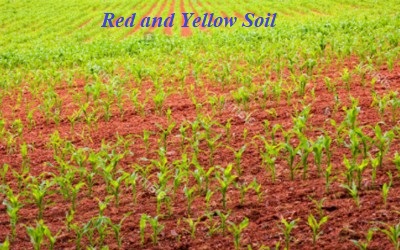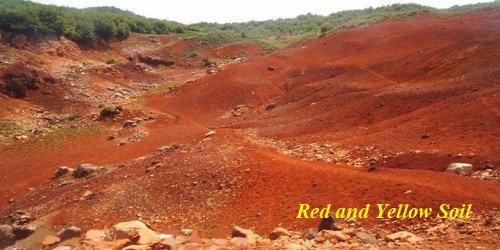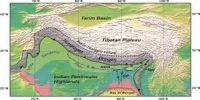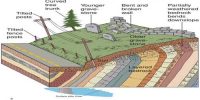Red and Yellow Soil in Indian Subcontinent
Red soil is a type of soil that develops in a warm, temperate, moist climate having a thin organic layer. Red soil gets its color from the iron found in its composition in a crystallized form. Red soil develops on crystalline igneous rocks in areas of low rainfall in the eastern and southern part of the Deccan Plateau. These soils form the third largest group of soils in India. The soil takes on a yellow color when it is hydrated. These soils are generally found in the Western Ghats, Odisha, and Chattisgarh.
- Composition: Rich in iron, poor in lime, phosphorous, calcium and nitrogen
- Formation: Decomposition of granite, gneiss and metamorphic rocks
- Characteristics: Not water retentive. When fertilizers are added, soil become productive
- Distribution: Tamil Nadu, Kerala, and Karnataka
- Crops: Bajra, maize, pulses, potatoes, fruits
Along the piedmont zone of the Western Ghat, a long stretch of the area is occupied by red loamy soil. Yellow and red soils are also found in parts of Orissa and Chattisgarh and in the southern parts of the middle Ganga plain. The soil develops a reddish color due to a wide diffusion of iron in crystalline and metamorphic rocks. It looks yellow when it occurs in a hydrated form. The fine-grained red and yellow soils are normally fertile, whereas coarse-grained soils found in dry upland areas are poor in fertility. Red soil in India has a lack of nitrogenous material, phosphoric acid, organic matter but the red soil id in rich in iron. The clay form of red soil is nutrient-rich and viable for forestation. They can produce excellent crops like cotton, jowar, linseed, fruits, millets, and potatoes. Red soil actually has a very low level of humus and require fertilizers when used for farming.

Formation: These are derived from granites, gneisses, and other metamorphic rocks – Zonal Soils. These are formed under well-drained conditions.
Areas: Along the piedmont zone of the Western Ghat, a long stretch of area is occupied by red loamy soil. Yellow and red soils are also found in parts of Orissa and Chattisgarh and in the southern parts of the middle Ganga plain.
Soil Colour: The soil develops a reddish color due to a wide diffusion of iron in crystalline and metamorphic rocks. It looks yellow when it occurs in a hydrated form.
Suitable Crops: In places where irrigation facilities are available, the crops cultivated are wheat, cotton, pulses, tobacco, millets, oilseeds, potato, maize, groundnut, and orchards.
Characteristic Features:
- The fine-grained red and yellow soils are normally fertile, whereas coarse-grained soils found in dry upland areas are poor in fertility.
- Seen mainly in the low rainfall area.
- Have a porous and friable structure.
- They are generally poor in nitrogen, phosphorous, and humus.
- These soils are airy and need irrigation for cultivation.
- Intense leaching is a menace in these soil areas.















